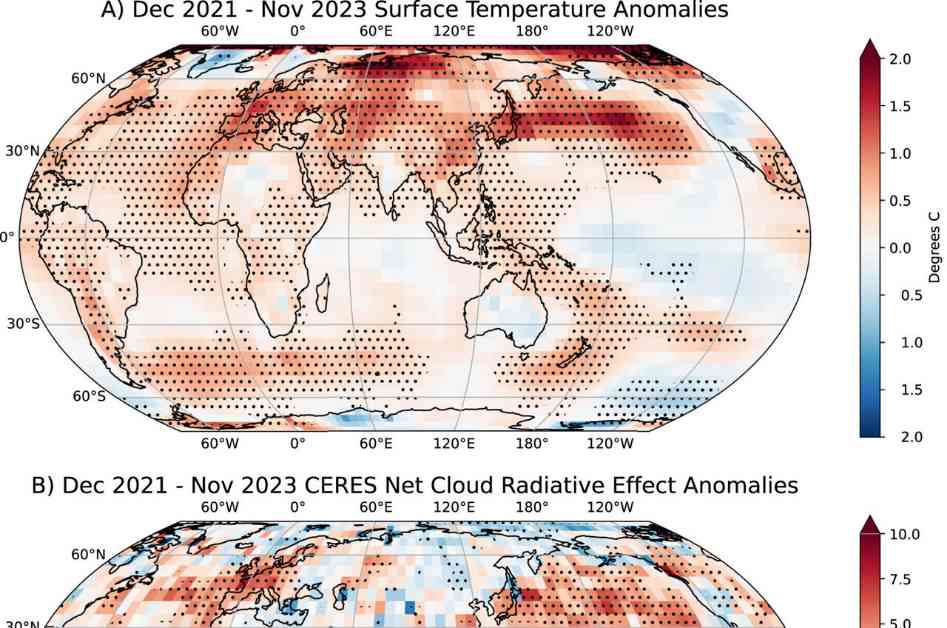Study Shows Shipping Emissions Regulations in 2020 Improved Air Quality but Accelerated Warming
In a groundbreaking study published in the journal Geophysical Research Letters, scientists at the Department of Energy’s Pacific Northwest National Laboratory revealed the impact of shipping emissions regulations enacted in 2020 on Earth’s climate. The study found that while the regulations led to improved air quality by reducing sulfur emissions from the shipping industry, they also accelerated warming, making 2023 the warmest year on record.
The regulations implemented by the International Maritime Organization required an 80% reduction in the sulfur content of shipping fuel used globally. This reduction significantly decreased the flow of sulfur aerosols into Earth’s atmosphere, leading to a decline in visible ship tracks and ultimately impacting the planet’s temperature.
Understanding the Impact of Sulfur Emissions on Climate
When ships burn fuel, sulfur dioxide is released into the atmosphere. This sulfur dioxide can undergo chemical reactions that result in the formation of sulfur aerosols. These aerosols can have both cooling and warming effects on the Earth’s climate.
Sulfur emissions can contribute to the formation of sulfate particles, which can lead to the creation of linear clouds known as ship tracks. These clouds have a cooling effect on the Earth’s surface by reflecting sunlight. However, the reduction in sulfur emissions meant fewer sulfate particles were available to form these clouds, resulting in a decrease in the cooling effect.
The Impact of Reduced Ship Emissions on Global Warming
The study used a machine learning approach to analyze over a million satellite images and quantify the decline in visible ship tracks. The researchers estimated a 25 to 50% reduction in the number of visible tracks, which corresponded to an increase in the Earth’s surface temperature.
By simulating the effects of the reduced ship emissions in climate models, the researchers found that approximately half of the potential warming from the emissions change materialized in just four years. This rapid warming trend is likely to continue as the climate response unfolds in the coming years.
Although changes in sulfur emissions played a significant role in the record warming of 2023, the authors noted that other factors, such as oscillating climate patterns and greenhouse gas concentrations, also contributed to the increased temperatures. The magnitude of warming observed in 2023 was too significant to be solely attributed to the reduction in emissions.
The Role of Aerosols in Climate Change
Aerosols, including sulfate particles from ship emissions, can mask a portion of the warming caused by greenhouse gas emissions. When aerosol concentrations suddenly decrease, as seen with the reduction in ship emissions, warming can spike. The short-lived nature of aerosols makes them a significant source of uncertainty in climate projections.
Earth scientist Andrew Gettelman, who led the study, emphasized the importance of understanding the climate response to changes in emissions as the world transitions to cleaner energy sources. As greenhouse gas emissions decrease, it will be crucial to monitor the impact of other pollutants, such as sulfur aerosols, on the Earth’s climate.
Future Implications and Uncertainties
The study highlights the complex interactions between aerosols, clouds, and climate change. While reducing sulfur emissions can improve air quality, it can also lead to unintended consequences, such as accelerated warming. The authors stressed the need for better data on ship emissions and improved modeling to enhance our understanding of these effects.
Moving forward, it will be essential to consider the potential impact of aerosols on global warming and to develop strategies to mitigate their effects. By addressing the complexities of aerosol-cloud interactions, researchers can gain valuable insights into how human activities influence the Earth’s climate and work towards more sustainable solutions for the future.






















